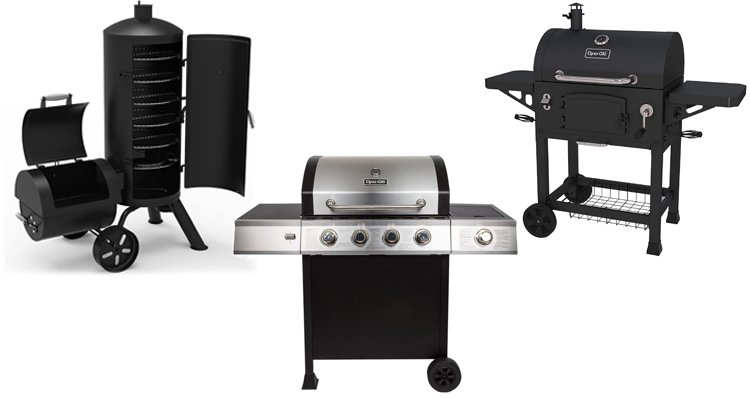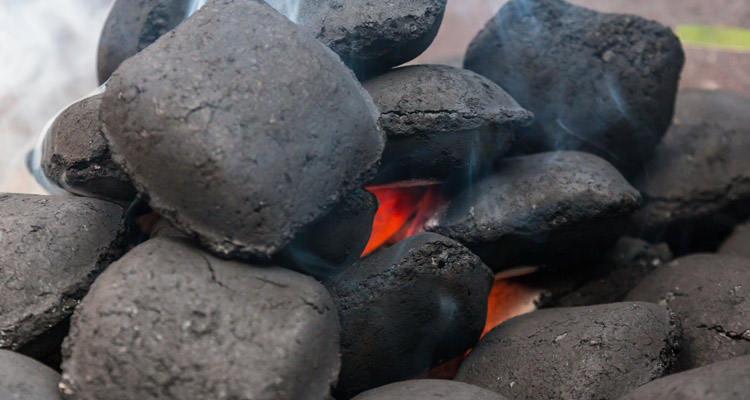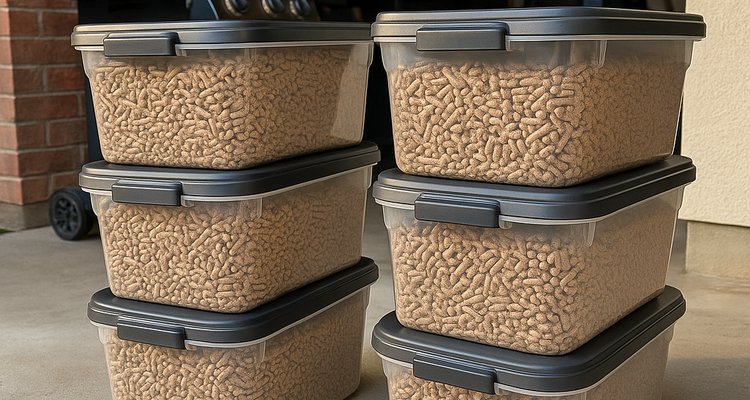
If you’ve ever loaded up your pellet grill only to find your pellets crumbling into sawdust or refusing to ignite properly, you already know the frustration of poor pellet storage. Moisture is the silent enemy of wood pellets, and improper storage doesn’t just waste money—it ruins your BBQ results with inconsistent temperatures, excessive smoke, and compromised flavor.
Poor pellet storage is the number one cause of temperature control problems in pellet grills. When pellets absorb moisture from the air, they expand, break apart, and lose their ability to burn efficiently. The result? Temperature swings that ruin your brisket, auger jams that halt your cook mid-session, and wasted bags of premium pellets that could have lasted months with proper storage.
In this comprehensive guide, we’ll walk you through everything you need to know about pellet storage containers. You’ll discover our top six container recommendations across different price points and capacities, learn the critical features that separate excellent containers from mediocre ones, and master the best practices for keeping your pellets dry and ready to deliver perfect smoke every time you fire up your grill.
Quick Roundup List
- Best Overall: Traeger Stay Dry Pellet Bin
- Best for Dust Filtering: Oklahoma Joe’s Pellet Bucket Kit
- Best Budget: Buddeez Storage Dispenser
- Best Large Capacity: Gamma2 Vittles Vault
- Best Multi-Purpose: Komax Biokips Extra Large Food Container
- Best Value: Buddeez Ice Melt Dispenser
Why You Need Proper Pellet Storage
Investing in quality pellet storage containers isn’t just about organization—it’s about protecting your investment and ensuring consistent BBQ performance. Here’s why proper storage matters:
– Moisture protection preserves pellet quality: Airtight containers create a barrier against humidity that degrades pellets and causes them to crumble.
– Prevents temperature fluctuations: Dry pellets burn consistently, maintaining steady temperatures throughout your cook.
– Organized storage for multiple flavors: Keep hickory, mesquite, apple, and cherry pellets separate and properly labeled to avoid flavor mixing.
– Space-efficient stackable designs: Maximize your garage or shed space with containers that stack securely without taking up valuable floor space.
– Prevents fungal growth and contamination: Moisture exposure can lead to mold growth that makes pellets unsafe to use.
– Maintains optimal burn performance: Fresh, dry pellets produce cleaner smoke and more predictable heat output.
– Saves money by extending pellet lifespan: Proper storage can extend pellet freshness from 3 months to 6 months or longer, reducing waste.
Top Pellet Storage Containers for 2025
Traeger Stay Dry Pellet Bin – Best Overall
The Traeger Stay Dry Pellet Bin represents the gold standard in pellet storage for serious grillers. Designed specifically for pellet grill owners, this container addresses every common storage challenge with thoughtful engineering and premium construction. The airtight lockable lid creates a complete moisture seal, protecting your pellets from humidity even in challenging climates.
What sets the Traeger bin apart is its integration with the Traeger ecosystem. The 22-pound capacity perfectly accommodates one full bag of pellets, and the dimensions are precisely sized to fit under the hopper on newer Traeger grills, making refills incredibly convenient. The stackable design means you can build a complete pellet storage system as your flavor collection grows.
The included sticker system—six pre-labeled flavor stickers plus six blank ones—eliminates confusion when you’re reaching for pellets mid-cook. This attention to detail extends to the container’s durability, with heavy-duty plastic construction that withstands garage temperature extremes without warping or cracking.
Highlights
- Airtight lockable lid seals out moisture completely
- 22-pound capacity holds one full bag of pellets
- Stackable design for convenient multi-flavor storage
- Includes 6 pre-labeled and 6 blank flavor stickers
- Fits under hopper on newer Traeger grills
Specifications
- Capacity: 22 lbs
- Material: Heavy-duty plastic
- Features: Airtight, stackable
- Best For: Traeger grill owners wanting premium pellet storage
Customer Reviews
- “Keeps pellets fresh for months, even in humid climates.”
- “Stackable design and labeling system make managing multiple flavors effortless.”
- “The tight seal is superior to generic storage containers.”
Oklahoma Joe’s Pellet Bucket Kit – Best for Dust Filtering
The Oklahoma Joe’s Pellet Bucket Kit brings a unique feature to pellet storage that competitors overlook: integrated dust filtering. Wood pellets naturally generate sawdust during shipping and handling, and this dust can cause auger jams and inconsistent burns. The built-in wire-mesh filter separates dust from pellets before they reach your hopper, ensuring cleaner burns and fewer mechanical issues.
This kit includes everything you need for optimal pellet handling: a weatherproof airtight lid, a heavy-duty plastic scoop for mess-free transfers, and the signature bucket-shaped filter that sits inside the container. The 20-pound capacity accommodates most pellet bags, and the weatherproof lid design means you can confidently store this container in unheated garages or sheds without worrying about moisture intrusion.
The dust-filtering capability isn’t just a nice-to-have feature—it’s a practical solution that extends the life of your pellet grill’s auger system and improves burn consistency. Users who’ve struggled with fine dust accumulation find this container invaluable for maintaining clean pellet flow.
Highlights
- Wire-mesh filter separates wood dust from pellets
- Weatherproof airtight lid protects against moisture
- Includes heavy-duty plastic scoop for easy handling
- Stores up to 20 pounds of hardwood pellets
- Bucket-shaped filter ensures clean burn performance
Specifications
- Capacity: 20 lbs
- Material: Heavy-duty plastic
- Features: Airtight, dust filtering
- Best For: Users who want dust-filtering capability
Customer Reviews
- “Significantly less sawdust buildup in hoppers.”
- “The included scoop makes pellet transfer cleaner and easier.”
- “Weatherproof lid maintains seal integrity even after years of use.”
Buddeez Storage Dispenser – Best Budget
The Buddeez Storage Dispenser proves that effective pellet storage doesn’t require a premium price tag. This versatile container brings together practical design features at a budget-friendly cost, making it an excellent choice for new pellet grill owners or those building a multi-container storage system without breaking the bank.
The flip lid design provides quick access for scooping pellets, while the bag-in feature is a clever innovation that lets you store the entire pellet bag inside the container. This not only keeps your container cleaner but also lets you identify the brand and flavor at a glance. The bag gripper keeps the pellet bag open and accessible, streamlining the refilling process during long cooks.
With 32 quarts of capacity (approximately 24 pounds), this container handles most pellet storage needs. The stackable design and included pour spout add versatility, and the polypropylene construction provides durability without the premium price. While not marketed as airtight like some competitors, the seal is adequate for typical garage storage, especially in arid or temperate climates.
Highlights
- Flip lid allows for easy scooping access
- Bag-In feature to identify brand and flavor
- Bag gripper keeps container clean
- Multi-purpose for pellets, charcoal, or wood chips
- Pour spout included for convenient dispensing
Specifications
- Capacity: 32 quarts (approx 24 lbs)
- Material: Polypropylene
- Features: Stackable, pour spout
- Best For: Budget-conscious buyers needing versatile storage
Customer Reviews
- “Versatile and affordable for organizing different fuel types.”
- “Pour spout functionality is particularly useful for refilling hoppers.”
- “Great value for creating a comprehensive fuel management system.”
Gamma2 Vittles Vault – Best Large Capacity
When you need serious pellet storage capacity with maximum freshness protection, the Gamma2 Vittles Vault delivers with its impressive 40-pound capacity and industry-leading Gamma Seal Technology. This container was originally designed for long-term food storage, bringing food-grade quality standards to your pellet storage needs.
The Gamma Seal lid system sets this container apart from competitors. The patented double-gasket design creates an airtight seal that’s virtually impervious to moisture, while the threaded locking system ensures the lid stays secure even when stacked. Unlike snap-on lids that can pop off or lose seal integrity over time, the Gamma Seal maintains consistent protection year after year.
Made from food-grade HDPE plastic and manufactured in the USA, the Vittles Vault offers premium construction quality. The stackable design means you can build vertical storage without sacrificing floor space, and the 40-pound capacity reduces the frequency of refills—perfect for serious grillers who go through pellets quickly or want to stock up during sales.
Highlights
- Gamma Seal Technology with double gaskets for superior airtight seal
- Threaded locking system ensures secure closure
- Stackable design for space-efficient organization
- Made from food-grade HDPE plastic
- USA-made quality construction
Specifications
- Capacity: 40 lbs
- Material: Food-grade HDPE plastic
- Features: Airtight, stackable
- Best For: Large capacity needs with maximum freshness protection
Customer Reviews
- “Pellets stay remarkably fresh even after months of storage.”
- “Multiple Vittles Vaults create a comprehensive storage system for various flavors.”
- “Food-grade construction quality exceeds expectations for this price point.”
Komax Biokips Extra Large Food Container – Best Multi-Purpose
The Komax Biokips Container brings kitchen-quality design to pellet storage with its innovative open-door hatch and multi-purpose functionality. While designed as a food storage container, its features translate perfectly to pellet storage needs—especially if you value convenient access over maximum capacity.
The standout feature is the open-door hatch with integrated 1-cup food scooper. This design lets you quickly grab pellets for hopper refills without removing the entire lid, which is particularly convenient during active cooks when you need to add pellets quickly. When closed, the container maintains an airtight seal that protects pellets from moisture.
Made from BPA-free polypropylene with heat-resistant properties, this container handles temperature extremes well. The material is dishwasher safe, making it easy to clean if you decide to repurpose it later. The 20+ pound capacity is adequate for most grillers, and the stackable design means you can organize multiple containers efficiently.
Highlights
- Open-door hatch with 1 cup food scooper for convenient access
- Airtight seal when closed protects against moisture
- BPA-free and dishwasher safe polypropylene construction
- Includes measuring cup (180 ml)
- Heat-resistant material handles temperature extremes
Specifications
- Capacity: 20+ lbs
- Material: BPA-free polypropylene
- Features: Airtight, stackable, easy access hatch
- Best For: Multi-purpose storage with easy access design
Customer Reviews
- “Quick-access hatch is much more convenient than fully removing lids.”
- “Food-grade quality and dishwasher-safe construction are excellent.”
- “Perfect for rotating between pellet storage and other dry goods storage.”
Buddeez Ice Melt Dispenser – Best Value
The Buddeez Ice Melt Dispenser delivers exceptional value with its massive 50-pound capacity and budget-friendly price point. Originally designed for ice melt and commercial applications, this rugged container adapts perfectly to pellet storage needs, especially for high-volume grillers who want maximum storage at minimum cost.
The patented flip lid and pop-up pour spouts make pellet dispensing incredibly easy. The dual pour spout design lets you control flow rate, whether you’re carefully filling a hopper or quickly transferring pellets. The EZ grip handles provide comfortable carrying even when the container is fully loaded with 50 pounds of pellets.
Built for commercial durability, this dispenser can handle the rough conditions of garage storage without cracking or warping. The 8-gallon capacity means fewer refills and the ability to stock up on pellets during sales. While not marketed as airtight, the lid keeps contents dry and ready to use in typical storage conditions, making it an excellent value choice for those prioritizing capacity over premium features.
Highlights
- Patented flip lid and pop-up pour spouts for easy dispensing
- EZ grip handles for comfortable carrying
- Holds up to 50 lbs of material—largest capacity in this lineup
- Rugged design built for commercial use
- Keeps contents dry and ready to use
Specifications
- Capacity: 8 gallons (50 lbs capacity)
- Material: Heavy-duty plastic
- Features: Pour spouts, grip handles
- Best For: Budget option with large capacity and pouring convenience
Customer Reviews
- “Excellent value—massive capacity at a fraction of premium container costs.”
- “Pour spout functionality makes hopper fills mess-free.”
- “Perfect for building a comprehensive storage system on a budget.”
Pellet Storage Container Comparison
| Model | Capacity | Material | Airtight | Stackable | Special Features | Best For |
|---|---|---|---|---|---|---|
| Traeger Stay Dry | 22 lbs | Heavy-duty plastic | Yes | Yes | Lockable lid, flavor stickers | Premium storage |
| Oklahoma Joe’s | 20 lbs | Heavy-duty plastic | Yes | No | Dust filter, scoop | Dust filtering |
| Buddeez Storage | 24 lbs | Polypropylene | No | Yes | Bag-in feature, pour spout | Budget versatile |
| Gamma2 Vittles | 40 lbs | Food-grade HDPE | Yes | Yes | Gamma Seal, double gaskets | Large capacity |
| Komax Biokips | 20+ lbs | BPA-free polypropylene | Yes | Yes | Easy access hatch | Multi-purpose |
| Buddeez Ice Melt | 50 lbs | Heavy-duty plastic | No | No | Dual pour spouts, handles | Budget value |
Buying Guide: What to Consider When Choosing Pellet Storage
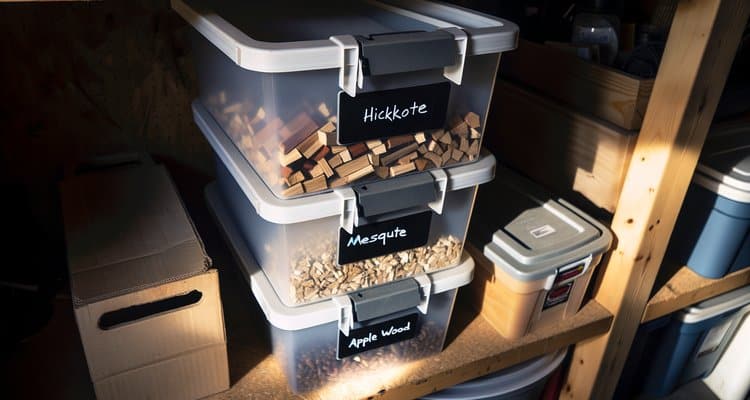
Selecting the right pellet storage container requires balancing capacity, features, and your specific grilling habits. Here’s what you need to consider to make an informed decision.
Capacity & Size Considerations
Storage capacity is the foundation of your decision. Start by assessing how many pounds of pellets you typically store at once. Most grillers fall into one of three categories:
Single-bag storage (20-25 lbs): If you purchase pellets one bag at a time and use them within a few weeks, containers in the 20-25 pound range are ideal. These fit one full bag and take up minimal space. They’re perfect for casual grillers or those with limited storage space.
Multi-flavor storage (multiple 20-25 lb containers): Enthusiasts who experiment with different wood flavors benefit from multiple moderate-capacity containers. This approach lets you organize hickory wood, mesquite wood, apple wood, cherry wood, and other wood varieties separately, preventing flavor mixing and making it easy to grab the right wood pellets for each cook.
Bulk storage (40-50 lbs): High-volume grillers who cook frequently or stock up during sales need larger capacity. The 40-50 pound containers reduce refill frequency and let you take advantage of bulk pricing. Consider how much space you have available and whether you’ll realistically use pellets before they degrade.
Don’t forget to measure your storage area before purchasing. Stackable containers maximize vertical space in garages and sheds, but you’ll need adequate clearance to comfortably remove lids. If storing under your grill’s hopper, verify dimensions match before ordering.
Material Durability
Container material directly impacts longevity and protection quality. Understanding material differences helps you match containers to your storage environment.
Food-grade HDPE plastic: High-density polyethylene offers superior durability and weather resistance. Food-grade certification means the plastic won’t leach chemicals and can withstand temperature extremes without warping. This premium material maintains seal integrity longer than standard plastics. Containers like the Gamma2 Vittles Vault use food-grade HDPE for maximum protection.
Standard heavy-duty plastic: Most pellet-specific containers use heavy-duty plastic that balances cost and durability. While not food-grade certified, these materials handle typical garage storage conditions well. They’re less expensive than food-grade options while still providing adequate protection in temperate climates.
Polypropylene: This versatile plastic offers good chemical resistance and heat tolerance. BPA-free polypropylene provides safe storage without premium pricing. It’s lighter than HDPE but still durable enough for pellet storage needs.
For outdoor or unheated storage, prioritize materials rated for temperature extremes. Plastic that becomes brittle in cold or warps in heat will fail when you need it most. Impact resistance matters too—containers get knocked around in garages, so choose materials that can take a hit.
Airtight Seal Importance
The airtight seal is arguably the most critical feature of any pellet storage container. Moisture is the enemy of pellet quality, and even moderate humidity exposure causes irreversible damage.
Why airtight matters: Wood pellets are compressed sawdust held together by lignin, a natural binder in wood. When moisture penetrates pellets, they expand and crumble, losing structural integrity. This creates excessive sawdust that clogs augers, causes temperature fluctuations, and produces poor smoke quality. An airtight seal prevents humidity from reaching your pellets, maintaining their original moisture content of around 5-8%.
Seal technologies compared: Simple snap-on lids provide basic protection but may allow slow moisture infiltration over time. Lockable lids with gaskets offer better protection by creating compression seals. Premium containers like those with Gamma Seal Technology use double gaskets and threaded locking systems that create virtually impenetrable barriers against moisture.
Climate considerations: In arid climates with low humidity, even basic weatherproof lids may suffice. However, if you live in humid regions or experience significant seasonal humidity changes, invest in containers with true airtight seals. The difference between a standard lid and an airtight gasket seal can mean the difference between pellets lasting 3 months versus 6 months or more.
Test seal quality before purchasing if possible. Quality lids require noticeable pressure to close and open, indicating good gasket compression. Cheap lids close easily but provide minimal moisture protection.
Portability Features
How you access and move pellets affects your grilling experience. Portability features transform storage containers from simple vessels into convenient grilling tools.
Handle design: Quality handles make a 40-pound container manageable. Look for ergonomic grips that distribute weight comfortably. Molded handles integrated into the container design are more durable than attached handles that can break under load. If you’ll frequently move containers, test the grip comfort with weight similar to a full pellet load.
Pour spouts and dispensers: These features eliminate scooping and reduce spills. Flip-top pour spouts let you control flow rate—essential when filling narrow hopper openings. Some designs include integrated scoops or measuring cups for precise pellet portioning. Pour spouts are particularly valuable for large-capacity containers where scooping from depth becomes awkward.
Weight considerations: A 40-pound capacity container holds 40 pounds of pellets plus container weight—often 45-50 pounds total. If mobility is important, consider multiple smaller containers instead of one large unit. Wheeled options exist for very large capacities, though they’re less common for standard pellet storage.
Lid removal: Screw-top lids provide excellent seals but require more effort to open. Snap-on lids with lock mechanisms balance security and convenience. If you refill your hopper frequently during long cooks, choose a lid style you can operate quickly with one hand.
Stackability for Multiple Pellet Types
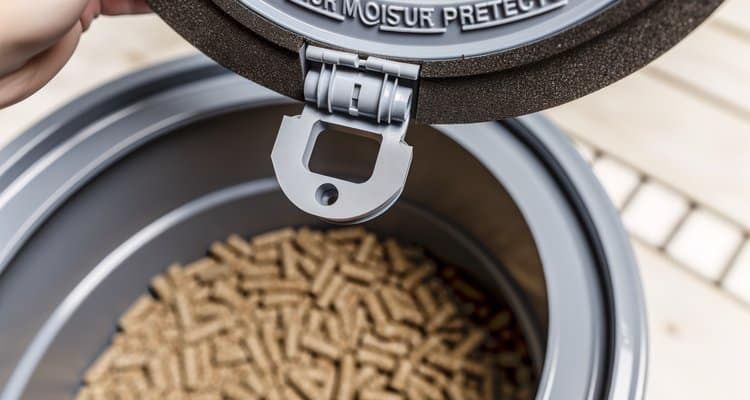
Building a multi-flavor pellet collection requires an organization strategy. Stackable containers maximize vertical space while keeping varieties separate and accessible.
Vertical storage advantages: Stackable designs let you store 3-4 containers in the same floor space as one. This is crucial in crowded garages or sheds where floor space is premium. Stable stacking requires containers with flat tops and bottoms designed to lock together or nest securely.
Labeling and identification: Clear containers let you identify pellet types at a glance, but labels are essential for opaque containers. Some containers include pre-printed flavor labels or blank spaces for custom labels. Waterproof marker-friendly surfaces are valuable if you rotate pellet brands and flavors frequently.
Preventing flavor mixing: Dedicated containers for each flavor prevent contamination. Even trace amounts of hickory can overpower delicate apple wood smoke. Separate storage ensures pure flavors and lets you blend intentionally when desired. If using one container for multiple flavors, thoroughly empty and clean it between uses.
Organization systems: Consider organizing by wood type (mild, medium, strong) or application (poultry, pork, beef). This makes it easy to grab the right pellets for your cook without reading every label. Some grillers use color-coded containers or lid tags for quick identification.
How to Store Wood Pellets Properly
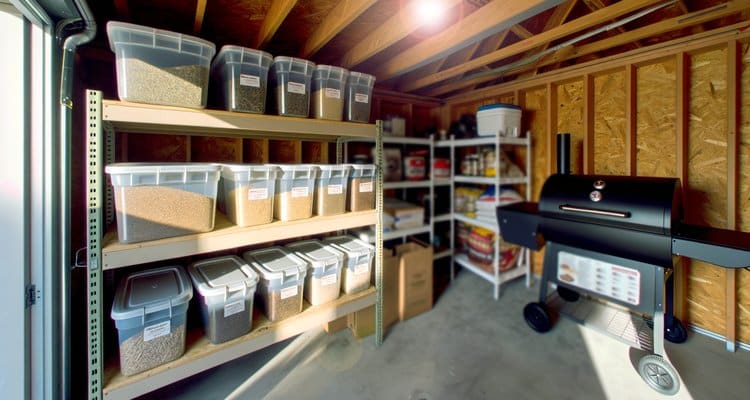
Even the best storage container can’t compensate for poor storage practices. Following these guidelines ensures maximum pellet longevity and quality.
Moisture Protection Best Practices
Indoor vs outdoor storage: Indoor storage in climate-controlled spaces is ideal but not always practical. If storing in an unheated garage or shed, choose containers with superior airtight seals. Never store pellets directly outdoors, even in covered areas—morning dew and rain splash create moisture exposure that degrades pellets quickly.
Climate-specific strategies: In humid climates, airtight containers are non-negotiable. Consider adding desiccant packets to containers if humidity is extreme. In arid climates, weatherproof containers may suffice, though airtight options still provide better long-term protection. Coastal areas require extra moisture vigilance due to salt air.
Hopper management: Remove pellets from your grill’s hopper if you won’t be cooking for more than a week. Hoppers aren’t airtight, and pellets left inside absorb ambient moisture. This practice is especially important before extended periods without grilling or when storing your grill for winter.
Common storage mistakes to avoid: Never store pellets on concrete floors where they can absorb ground moisture through container bottoms. Use shelving or pallets to create airflow underneath. Don’t store containers near water heaters, washing machines, or other moisture sources. Avoid partially opening bags within containers—either store the full sealed bag or transfer all pellets to the container.
Temperature Considerations
Ideal storage temperature: Room temperature (60-75°F) is optimal for pellet storage. This range maintains pellet integrity without causing expansion or contraction cycles that can damage the compressed structure.
Heat exposure effects: Excessive heat (above 90°F sustained) can cause pellet expansion and premature breakdown. Never store containers in direct sunlight or near heat sources like furnaces or hot water heaters. Heat also accelerates any moisture-related degradation if containers aren’t perfectly sealed.
Freezing temperature impacts: Cold temperatures don’t directly damage pellets, but temperature cycling between freezing and thawing can cause condensation inside containers. If storing in unheated spaces that freeze, ensure containers are absolutely airtight to prevent condensation damage. Let frozen pellets warm to room temperature before use to avoid auger jams.
Garage storage considerations: Garages work well for pellet storage in most climates, but be aware of temperature extremes. Park vehicles outside before storing pellets to prevent exhaust exposure. Keep containers away from garage doors where temperature fluctuations are greatest.
Organization Tips for Multiple Pellet Flavors
Labeling systems: Invest time in a clear labeling system from the start. Include wood type, purchase date, and brand on each label. Update labels when refilling to track freshness. Waterproof labels or permanent markers prevent label deterioration in garage conditions.
Rotation strategies: Use the oldest pellets first to prevent waste. Date your containers at purchase and organize them with oldest in front. This “first in, first out” approach ensures you’re always using the freshest stock available.
Preventing cross-contamination: Use dedicated scoops for each flavor, or thoroughly clean scoops between uses. Even small amounts of strong woods like mesquite can overpower delicate flavors. If storing pellet bags inside containers, keep bags sealed until ready to use.
Strategic organization: Store frequently used flavors in the most accessible locations. Group similar woods together—fruit woods in one area, heavy smoke woods in another. This organization makes it easy to find what you need quickly when you’re ready to grill.
Seasonal Storage Advice
Summer humidity management: High humidity is pellet enemy number one. Check container seals monthly during humid months. If you notice condensation inside containers, your seals have failed—transfer pellets to better containers immediately. Consider using a dehumidifier in your storage area if humidity is consistently high.
Winter cold weather storage: Cold itself doesn’t damage pellets, but bringing frozen pellets into a warm grill can cause condensation. Let containers warm gradually before opening. If moisture accumulates on the outside of containers brought in from cold storage, dry them thoroughly before opening to prevent water dripping into pellets.
Off-season long-term storage: If storing pellets for 6+ months over winter, take extra precautions. Ensure containers are absolutely airtight, store in the driest available location, and consider vacuum-sealing smaller quantities. Inspect pellets before first use in spring—if they crumble easily or show moisture damage, discard them rather than risk poor grill performance.
Pellet lifespan expectations: In optimal storage conditions with airtight containers, high-quality pellets remain usable for 6-12 months. Without airtight protection, pellets degrade in 2-4 months depending on humidity. Always perform the snap test before use—fresh pellets snap cleanly, while degraded pellets crumble or bend.
Signs Your Pellets Have Gone Bad
Even with proper storage, pellets eventually degrade. Knowing when to discard compromised pellets prevents poor grilling results and potential equipment damage.
Visual indicators: Fresh pellets have a slightly shiny appearance with consistent color. Degraded pellets look dull, show cracks or chips, and may have inconsistent coloring. Visible mold, fungal growth, or dark spots indicate moisture contamination—discard these pellets immediately.
The snap test: This simple test determines pellet quality instantly. Take a pellet and snap it in half. Fresh pellets snap cleanly with minimal dust. Bad pellets crumble, bend without breaking, or generate excessive dust. Perform this test on several pellets from different areas of your container for accurate assessment.
Excessive sawdust or clumping: Some sawdust is normal, but if you notice a thick layer of dust at the container bottom or pellets sticking together in clumps, moisture damage has occurred. Clumped pellets won’t flow properly through augers and can cause jams.
Fungal growth signs: White, gray, or green growth on pellets indicates fungal contamination from moisture exposure. Moldy pellets are unsafe to use—the smoke can carry spores and create unpleasant flavors. If you find mold in your container, thoroughly clean and dry the container before adding fresh pellets.
When to discard: If pellets fail the snap test, show visible mold, have absorbed significant moisture, or produce poor smoke quality, discard them. Don’t try to salvage bad pellets—they’ll cause more problems than they’re worth. Use compromised pellets for garden mulch or pathway filler rather than burning them.
Pellet disposal best practices: Degraded pellets make excellent garden mulch when fully decomposed. Spread them thinly in garden beds where they’ll break down and add organic matter. Avoid using treated or flavored pellets near edible plants. Alternatively, bag degraded pellets for regular trash disposal.
Frequently Asked Questions
Do wood pellets go bad?
Yes, wood pellets degrade over time when exposed to moisture. The lignin that binds compressed sawdust into pellets breaks down when it absorbs humidity, causing pellets to expand, crumble, and lose burn efficiency. In humid conditions without airtight storage, pellets can become unusable in as little as 2-3 months. Proper airtight storage in dry conditions can extend pellet life to 6-12 months or more.
How long do pellets last in storage?
Storage duration depends heavily on conditions. With airtight storage in low humidity environments, quality pellets remain usable for 6-12 months. In moderate humidity with airtight containers, expect 4-6 months of usability. Without airtight protection in humid climates, pellets degrade in 2-3 months. The snap test is your best indicator—if pellets snap cleanly rather than crumbling, they’re still good regardless of age.
Can you store pellets in the garage?
Yes, garage storage works well for most climates when using airtight containers. Garages offer protection from direct weather exposure while remaining accessible. In humid climates, ensure containers have superior airtight seals to combat seasonal humidity changes. In arid climates, even weatherproof containers provide adequate protection. Avoid storing directly on concrete floors—use shelving to prevent ground moisture absorption.
What is the best temperature for pellet storage?
Room temperature around 60-75°F is ideal for pellet storage. This range maintains pellet structural integrity without causing expansion or contraction. Pellets tolerate cold temperatures well, but avoid repeated freeze-thaw cycles that can cause condensation inside containers. Keep pellets away from heat sources above 90°F, as excessive heat can cause premature degradation and expansion.
How can you tell if pellets are bad?
Use the snap test as your primary indicator. Fresh pellets snap cleanly in half with minimal dust, while bad pellets crumble, bend without breaking, or generate excessive dust. Visual signs include dull appearance, cracks, and inconsistent coloring. Moisture-damaged pellets may show clumping, have excessive sawdust accumulation, or display visible mold growth. If pellets fail the snap test or show moisture signs, discard them.
Should I remove pellets from the hopper?
Yes, remove pellets from your hopper if you won’t be grilling for more than a week, especially in humid conditions. Hoppers aren’t airtight, allowing pellets to absorb ambient moisture that degrades quality and can cause auger jams. For short-term storage (a few days) in dry climates, leaving pellets in the hopper is acceptable. Always remove pellets before long-term storage or when storing your grill for winter.
Can I mix different pellet flavors in one container?
While possible, mixing flavors isn’t recommended unless you’re intentionally creating a custom blend. Strong woods like hickory or mesquite can overpower delicate fruit woods even in small amounts. If you want pure flavor control, use separate containers for each variety. If you do mix flavors, understand that the blend can’t be separated later, and strong wood flavors will dominate the profile.
Conclusion
Proper pellet storage is one of the simplest yet most impactful investments you can make in your BBQ setup. Quality storage containers protect your pellets from the moisture damage that causes temperature swings, auger jams, and wasted fuel. Whether you choose the premium features of the Traeger Stay Dry Bin, the dust-filtering capability of Oklahoma Joe’s Pellet Bucket, or the exceptional value of the Buddeez Ice Melt Dispenser, you’ll immediately notice the difference that fresh, properly stored pellets make in your grilling results.
Remember that the container is just part of the equation. Combining quality airtight storage with smart practices—removing pellets from hoppers between cooks, organizing multiple flavors efficiently, and performing regular quality checks—ensures your pellets stay fresh from purchase to burn. The small investment in proper storage pays dividends through better temperature control, cleaner smoke, and longer pellet lifespan.
Take stock of your current pellet storage situation. If you’re dealing with degraded pellets, inconsistent temperatures, or simply tired of fighting moisture damage, now is the time to upgrade your storage system. Select the container that matches your capacity needs, storage environment, and budget. Your grill—and your BBQ results—will thank you for it.
For more information on choosing the right pellets for your grill, check out our guide to the best wood pellets for smoking. If you’re shopping for a new grill to go with your pellet storage system, explore our reviews of the best portable pellet grills, top vertical pellet smokers, and best Pit Boss pellet grills. And for those just getting started with BBQ, don’t miss our comprehensive BBQ guide for beginners.
Contents







